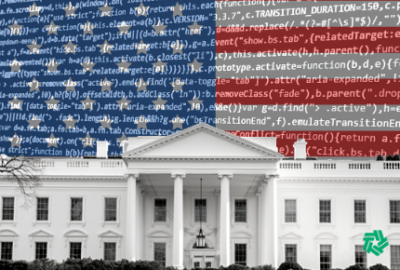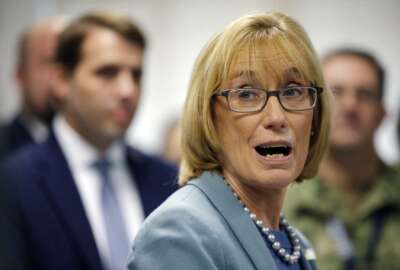

OMB released new guidance to agencies today for how the Technology Modernization Fund board will loan out the windfall funding Congress approved.
Best listening experience is on Chrome, Firefox or Safari. Subscribe to Federal Drive’s daily audio interviews on Apple Podcasts or PodcastOne.
If federal chief information officers and program managers want to get their hands on some of the $1 billion in the Technology Modernization Fund, they have less than a month to put their plan together.
The Office of Management and Budget set a deadline of early June for proposals to receive expedited consideration. But the TMF Board will accept proposals on a rolling basis going forward after that early June initial deadline.
OMB released new guidance to agencies today for how the board will loan out the windfall funding Congress approved in the American Rescue Plan.
“The TMF enables multi-year transformational projects by ensuring federal agencies have resources that exist throughout the lifecycle of modernization. We plan to use these resources to enable the federal government to better respond to SolarWinds and the COVID-19 crisis, and to support the economic recovery,” said Federal Chief Information Officer Clare Martorana in a release.
The guidance comes about two months after lawmakers passed and President Joe Biden signed the American Rescue Plan. Lawmakers and industry have been pushing OMB to act quickly so agencies can take advantage of the funding opportunity, which is more than a 3,900% increase of what Congress previously passed in fiscal 2020 and 2019.
“Smart IT investments are integral to the federal government’s mission and were the driving reason behind our effort to secure $1 billion for the TMF in the American Rescue Plan,” said Rep. Gerry Connolly (D-Va.), who co-authored the Modernizing Government Technology (MGT) Act and the Federal IT Acquisition Reform Act (FITARA). “The administration was quick to take the opportunity to brief and engage my subcommittee on their plans, and I look forward to continuing my work with them to ensure the TMF is adequately reimbursed and agile IT modernization becomes the norm across government.”
The new guidance will try to address one of the biggest areas of concern for agencies — the repayment model.
While the seven agencies who have received TMF loans previously report some payback so far, many experts and former agency CIOs said the repayment model is the biggest obstacle to widespread use of the program.
“I am pleased [to] see OMB and GSA recognize that changes to the TMF process, particularly related to repayment, were needed to incentivize use of the fund. While the devil will be in the details of how the repayment agreements are structured, the changes announced today are a step in the right direction,” said Mike Hettinger, president and founding principal of Hettinger Strategy Group and a former Hill staff member.
OMB laid out three options for repayment:
“TMF projects are proposed in a two-phase process. The Initial Project Proposal (IPP) is brief, and gives the board the information they need to make an initial determination,” the guidance states. “The Full Project Proposal (FPP) provides the board a detailed project analysis. The IPP should include basic high-level analysis that indicates whether the agency can repay the full TMF award amount or whether repayment flexibility is appropriate. In the FPP, agencies should provide detailed financial information and project impact analysis. The agencies’ analysis in the FPP should include a proposed repayment framework, or a case for why repayment flexibility should be extended, based on the repayment considerations above.”
One agency CIO, who requested anonymity because they didn’t get permission to speak to the press, said the repayment requirement is a fatal flaw with the TMF.
“Agencies hate repayment agreements of any kind for a wide variety of reasons,” the CIO said. “[The flexibility] does not make it more appealing — except to the U.S. Digital Service, which because of their mission, won’t ever have to pay back a cent. The TMF Board must now transform into something that it is not: A bank, with loan officers — or even better, Congressional authorizers AND appropriators. Most of the roles on the TMF board lack the requisite experience, oversight and insight, and there is no rigorous process that defines how to manage risk.”
In addition to the changes in repayment options, the General Services Administration plans to improve its approach to collecting fees to help manage the TMF loan process and meeting administrative costs to manage the fund. The Government Accountability Office found in a December 2019 report that GSA collected only about 3% of the fees it was owed to pay for administrative costs of the TMF.
“GSA will generally review and update that fee schedule annually. GSA will also update that fee schedule, as appropriate, to manage the increased costs of a larger portfolio of projects. Additionally, GSA may introduce project fee caps intended to ensure projects with a high cost are paying an appropriate fee that is proportional to the TMF Program Management Office’s administrative workload,” the guidance stated.
Other experts said OMB and Congress must refocus on getting agencies access to working capital funds, maybe a more important, but less heralded part of the MGT Act.
Rich Beutel, a former Hill staff member who shepherded FITARA through the House process and now president of Cyrrus Analytics, said agencies need to be able to take savings and transform them into multi-year money to allow for better management of IT modernization efforts.
Through the TMF funding, OMB told agencies to focus their proposals on four main areas: cybersecurity, high priority systems, public facing systems and the move to shared services.
Matthew Cornelius, the executive director of the Alliance for Digital Innovation, an industry association, and a former senior technology and cybersecurity advisor at OMB, said in an email to Federal News Network that priority investment areas make sense.
“This new process creates a real multi-dimensional chess game for agencies. They must figure out what projects they have that they would like funded, if and how they fit in the new categories and in some form of repayment bucket, and then if they go to the TMF versus working through the normal budget and appropriations process,” he said. “The fact is that OMB and the TMF board should already have a list of key priority areas developed over the past 15 months where they want to see this money, specifically, be put to use. Where that means agencies submit their own proposals, great – but there has to be a more aggressive top down push from the White House to bring agencies to the table to solve some of these governmentwide IT and cybersecurity issues made evident in the priorities.”
The agency CIO said cybersecurity remains the top priority, but TMF is not a good way to pay for upgrades.
“It’s like taking out a loan to buy gas for your car. The rest of the investment areas don’t move the needle, and essentially create a billion dollar slush fund for the U.S. Digital Service,” the CIO said. “The problem won’t be spending the funding; the problem will be identifying not only investments that align with the four priorities, but more so, good investments in sound programs. Further, even if a program is funded through the TMF, will Congress appropriate sustaining funding once the program is deemed ‘successful?’ What will Congress do if money is spent on priorities they don’t share — will there be penalties under regular appropriations?”
David Wennergren, the CEO of the American Council for Technology and Industry Advisory Council (ACT-IAC) and a former Defense Department deputy CIO and vice chairman of the CIO Council, said despite progress on IT modernization over the last few years, including moving to the cloud, agencies still face a huge uphill climb.
“A focus on customer experience, improving service delivery, as well as the movement to digital solutions are both crucial and required by statute. And, a continuing emphasis on shared services opportunities will also allow more government agencies to focus on their core mission and have IT operations and support services provided by experts,” he said. “And while prioritizing on these four areas will be important, it will also be good to recognize the power of managed services solutions, the importance of more rapid adoption of emerging technologies, and a more agile, incremental approach to solution delivery to better engage the customer and deliver measurable results rapidly.”
Hettinger added that focusing on cybersecurity and digital services makes the most sense as these areas have been ripe for investment for decades.
“As someone who was involved at the early stages of the TMF, I have always believed the fund should be used for projects that will make a difference in how citizens interact with and view their government,” he said. “When you add the challenges of the last year, including pandemic-related remote work requirements, you have a perfect storm that highlights the need for increased investments in these areas.”
Copyright © 2025 Federal News Network. All rights reserved. This website is not intended for users located within the European Economic Area.
Jason Miller is executive editor of Federal News Network and directs news coverage on the people, policy and programs of the federal government.
Follow @jmillerWFED


